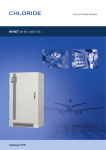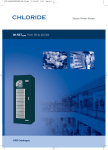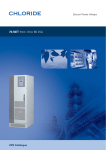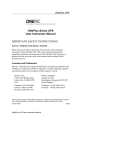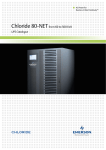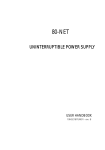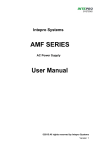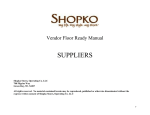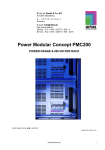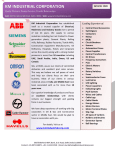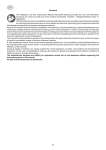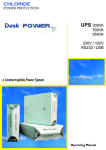Download 90-NET - DESITEK A/S
Transcript
Secure Power Always 90-NET from 250 to 800 kVA UPS Catalogue Important note! The technical data enclosed is for general information. Please note that the operating instructions and references indicated on the products are for installation, operation and maintenance. Product designations All product designations used are trademarks or product names of Chloride Group PLC or its subsidiary companies. This publication is issued to provide outline information and is not deemed to form any part of any offer or contract. The company has a policy of continuous product development and improvement and we therefore reserve the right to vary any information quoted without prior notice. Person to contact Uninterruptible Power Supply Systems UPS Catalogue • 2008 90-NET from 250 to 800 kVA 01 Scope 2 System description 2 Device description 3 General requirements 5 AC/DC converter 5 Control unit, IGBT inverter 8 Electronic static switch 9 Monitoring and control, interfaces 10 Mechanical data 16 Environmental conditions 16 Technical data (250 to 800 kVA) 17 Options 21 Parallel configurations 22 Appendix: Planning and Installation 28 MKA4CAT0UK90NET/Rev. 14-02/2008/UK CHLORIDE 90-NET UPS Systems from 250 to 800 kVA 1 Scope This specification describes a continuous duty three-phase, solid state, insulated gate bipolar transistor (IGBT) uninterruptible power supply (UPS) system. The UPS shall automatically provide continuity of electrical power, within defined limits and without interruption, upon failure or degradation of the commercial AC source. The continuity of conditioned electric power shall be delivered for the time period defined by the battery system. The inverter, and other mission critical converters within the UPS, are driven by vector control algorithms (covered by patents 95 P3875, 95 P3879 and 96 P3198) running on dedicated digital signal processor (DSP) systems. to ensure the complete protection of the loads. The UPS shall automatically provide continuity of electrical power, within defined limits and without interruption, upon failure or degradation of the commercial AC source. The duration of autonomy (i.e. back up power time) in the event of network failure shall be determined by the battery capacity. 2 System description This specification describes a static UPS in intelligent double conversion configuration, as shown in Figure 1. The systems shall operate on a microprocessor-based IGBT inverter. The vector control technology will enhance the performance of the inverter. In order to increase system redundancy, an independent electronic static bypass shall be integrated into the UPS. By adding system components, such as parallel kits, central output cubicles, CROSS switches, safety and disconnecting devices, system bypass switches, in addition to software and communications solutions, it shall be possible to set up elaborate systems 2.1 The system The UPS shall provide high quality AC power for electronic equipment loads and shall offer the following features: • Increased power quality • Full noise rejection • Full compatibility with all types of loads • Power blackout protection • Full battery care Maintenance Bypass (only for 250 to 500 kVA) Fuse Reserve Mains Regular Mains Reserve switch Load Switch Fuse Output switch Rectifier Inverter Electronic Bypass switch Electronic Battery switch Battery Fuse Battery switch LIFE.net Connectivity bundled. Basic signalling Battery Fuse Optional remote Connectivity (IP; SNMP; J-BUS; PROFIBUS;Etc.) Battery System Figure 1. 90-NET single block system. (Note: for 600 and 800 kVA the maintenance bypass has to be provided externally). MKA4CAT0UK90NET/Rev. 14-02/2008/UK 02 CHLORIDE 90-NET UPS Systems from 250 to 800 kVA 2 System description 2.2 Models Available MODEL Rating (kVA) The 90-NET range shall include the following three-phase input/output models: 90-NET/250 250 90-NET/300 300 90-NET/400 400 90-NET/500 500 90-NET/600 600 90-NET/800 800 3 Device description 90-NET is the result of an innovative research and development programme designed to offer users the most reliable power supply at a minimum cost. 3.1 Components The UPS shall consist of the following major components: • Rectifier/battery charger/electronic battery switch • IGBT inverter • Digital signal processor (DSP) • Electronic static switch and reserve supply • Manual maintenance bypass switch • Matching battery cubicles 3.2 Microprocessor control and diagnostics Operation and control of the UPS shall be provided through the use of microprocessor-controlled logic. Indications, measurements and alarms, together with battery autonomy, shall be shown on an illuminated, forty character liquid crystal display (LCD). The procedures for start up, shutdown and manual transfer of the load to and from bypass shall be explained in clear step-by-step sequences on the LCD display. 3.3 Intelligent double conversion operating modes 90-NET shall adopt intelligent double conversion technology which allows the UPS to operate in double conversion or digital interactive mode according to the selected priority. The UPS will operate as follows: 3.3.1 Double Conversion Mode 3.3.1.1 Normal The UPS inverter continuously supplies the critical AC load. The rectifier/charger derives power from the commercial AC source and converts it into DC power for the inverter whilst simultaneously maintaining the battery in a fully charged and optimum operational condition (for more details see section 5.11 “Battery Management”). The inverter converts the DC power into clean and regulated AC power which is supplied to the critical load through the static transfer switch. The static switch monitors and ensures that the inverter tracks the reserve supply frequency. This ensures that any automatic transfer to the reserve supply (due to an overload etc.) is frequency synchronised and does not cause interruption to the critical load. 3.3.1.2 Overload In the event of an inverter overload, manual stop or failure the static switch shall automatically transfer the critical load to the reserve supply without interruption. 3.3.1.3 Emergency Upon failure or reduction of the commercial AC source (see table 12 for tolerances), without switching, the inverter shall supply the critical load, drawing power from the associated battery. There shall be no interruption to the critical load upon failure, reduction or restoration of the commercial AC source. While the UPS is powered by the batteries, indications shall be provided of actual autonomy time remaining as well the duration of the mains failure. 03 3.3.1.4 Recharge Upon restoration of the commercial AC source, even where batteries are completely discharged, the rectifier/ charger shall restart automatically, 'walk in' and gradually take over both the inverter and battery recharge loads. This function shall be fully automatic and shall cause no interruption to the critical load. 3.3.2 Digital interactive mode If priority has been set to digital interactive mode, intelligent double conversion technology shall allow 90-NET to continuously monitor the condition of the input supply including its failure rate to ensure maximum reliability for critical users. On the basis of the analysis performed, it shall decide whether to supply the load through the direct line or the conditioned line. This operational mode, which allows significant energy savings by increasing the overall AC/AC efficiency of the UPS (see section 11.6), is primarily intended for general purpose ICT applications. However, it does not provide the same output power quality as when the UPS operates in double conversion mode. Therefore it will be necessary to verify whether this mode is appropriate for special applications. Digital interactive mode is not available for parallel systems. 3.3.2.1 Normal The operating mode will depend on the quality of the mains supply in the short-term past. If the line quality has remained within permitted tolerance parameters in this timeframe, the direct line will provide continuous supply to the critical AC load through the static switch. The IGBT inverter will remain in constant operation and synchronisation with the direct line. MKA4CAT0UK90NET/Rev. 14-02/2008/UK CHLORIDE 90-NET UPS Systems from 250 to 800 kVA 3 Device description This ensures that the load can be transferred to the conditioned line without a break in the supply where there is a deviation from the selected input power tolerance levels. If the direct line failure rate has been outside permitted parameters, 90-NET shall supply the load from the conditioned line. The battery charger supplies the energy necessary for maintaining maximum charge to the battery. 3.3.2.2 Inverter stop or overload If the inverter is stopped either by the operator or as a result of an overload, there is no transfer to the conditioned line and the load continues to be supplied by the direct line. The mains voltage and frequency values must be within the tolerance limits specified. In the event of an overload with a duration in excess of the maximum capacity specified, the load is transferred to the conditioned line, which will supply it for a specific time depending on the level of overload. In the event of an overload and an unsuitable mains supply, 90-NET shall transfer the load from the direct line to the conditioned line (assuming 90-NET was operating from the direct line) and the inverter shall continue to supply the critical load for a period dependant on the degree of the overload and the UPS features. Visual and audio alarms alert the user to the problem. 3.3.2.3 Emergency (due to mains supply failure or variance beyond tolerance limits) If 90-NET is supplying the load via the direct line and the mains supply varies beyond tolerance levels (adjustable using the software from ± 2% to +10% -8%), the load will be transferred from the direct line to the conditioned line. The load is powered from the mains via the rectifier and inverter, (provided the input mains remains within the tolerances stated in table 12). Should the input mains fall below the lower limit the batteries shall be used to power the load via the inverter. The user is alerted to the battery discharge by visual and audio alarms and the remaining autonomy is displayed on the LCD. During this process, it is possible to extend the remaining autonomy by switching off non-essential loads. MKA4CAT0UK90NET/Rev. 14-02/2008/UK 3.3.2.4 Return to normal conditions 3.4.1 Vector control When the mains supply returns to within tolerance limits, 90-NET will continue to supply the load via the conditioned line for a period of time dependant on the direct line failure rate (the conditioned line draws power from the mains not the battery). When the direct line has stabilised, 90-NET returns to normal operation. The battery charger automatically begins to recharge the battery, so that maximum autonomy is guaranteed in the shortest possible time. To ensure the quick and flexible processing of measuring data, special arithmetic algorithms shall be implemented in DSP, rapidly generating controlled variables as a result. This will thus render possible the real-time control of the inverter electronics, resulting in obvious advantages concerning the performance of the power components. These advantages will be: 3.3.3 Maintenance bypass If, for any reason, it is necessary to take the UPS out of service for maintenance or repair, the UPS shall be fitted with an internal maintenance bypass switch (250 to 500kVA only) which enables a load transfer to a bypass supply with no interruption to power to the critical load (for 600 and 800kVA models the manual bypass switch is not present, therefore it shall be provided externally in the distribution. This external bypass shall be equipped with an auxiliary contact, which shall be remoted to the UPS using the appropriate signal input). Bypass isolation shall be complete, all serviceable components such as fuses, power modules etc. shall be isolated. 3.3.4 Operation Without Battery If the battery is taken out of service for maintenance, it is to be disconnected from the rectifier/charger by means of a switch situated in the UPS cabinet. The UPS will continue to operate and meet the performance criteria specified with the exception of the stand-by period. In such a case, the overload performance from the conditioned line may also be affected, depending on the actual input voltage level. • Improvement of short circuit behaviour, as individual phases can be more quickly controlled • Synchronism or phase angle precision between UPS output and reserve supply even in the case of a distorted mains voltage. • High flexibility in parallel operation: parallel blocks may be housed in separate rooms. Several algorithms included in the Vector Control firmware are covered by patents owned by Chloride (95 P3875, 95 P3879 and 96 P3198). 3.4.2 Redundancy, preventive monitoring In order to maximise the reliability of the system, the control unit shall monitor a wide number of operating parameters for the rectifier, inverter and battery. All vital operating parameters, such as temperatures, frequency and voltage stability at the system output, load parameters and internal system values shall be constantly monitored and controlled for irregularities at all times. The system shall react automatically before a critical situation arises either for the UPS or the load, in order to ensure the supply of the load even in these difficult conditions. 3.4.3 Telediagnosis and telemonitoring 3.4 Control and diagnostics Control of the power electronics modules shall be optimised in order to provide: • optimum three-phase supply of the load • controlled battery charging • minimum phase effects upon the supply network. By using digital signal processors (DSP) 90-NET shall implement the most advanced digital control. 04 In all the above modes of operation, the UPS may be monitored and controlled from a remote location such as a service centre, in order to maintain the reliability of the system at nominal levels. Even during complete shutdown of the UPS, information relating to the operating parameters shall not be lost thanks to non volatile RAMs, which will store the information for up to 10 years. CHLORIDE 90-NET UPS Systems from 250 to 800 kVA 4 General Requirements 4.1 Applied standards Chloride operates a Quality Management System which complies with BS EN ISO 9001-2000 for the design, manufacture, sales, installation, maintenance and service of uninterruptible power supply systems. The Chloride Environmental Policy and Management Systems comply with EN ISO 14001 and Chloride is committed to implementing a policy of continuous improvement to production processes and pollution reduction. 4.2 Safety In terms of general and safety requirements, the UPS conforms to standard IEC EN 62040-1-2 governing use in restricted access locations. 4.3 EMC and surge suppression • IEC EN 62040-1-2 general and safety requirements Electromagnetic effects (of internal or external origin) shall be minimised in order to ensure that computer systems and other similar electronic loads shall neither be adversely affected by nor affect the UPS. The UPS shall be designed to meet the requirements of IEC EN62040-2. The manufacturer and customer in partnership agree to ensure the essential EMC protection requirements for the specific resulting installation (with particular emphasis on surge suppression). • IEC EN62040-2 EMC requirements 4.4 Neutral connection and grounding • IEC EN62040-3 operating requirements The 90-NET output neutral shall be electrically isolated, except for RFI filters, from the UPS chassis. The input and output neutral connections are the same, i.e. they are solidly tied together. 90-NET shall carry the CE mark in accordance with the Safety and EMC Directives 2006/95 and 2004/108. 90-NET is designed and manufactured in accordance with the following international standards: • Surge withstandability EN61000-4-5, level 3. Therefore the UPS shall not modify the state of the upstream neutral, in any operating mode, and the neutral state of the distribution downstream from the UPS is imposed by the mains one. 90-NET should be used in installations with grounded neutral; for further details please contact Chloride Technical Support. 4.5 Materials All materials and components comprising the UPS shall be new and of current manufacture. 5 AC/DC Converter 5.1 General/Input The three-phase current taken from the commercial AC source shall be converted to a regulated DC voltage by a 12-pulse rectifier (consisting of two 6-pulse thyristor rectifiers operating at a phase shift of 30°) and harmonic filters as standard. In order to protect the power components within the system each phase of the rectifier input shall be individually fitted with a fast-acting fuse. The rectifier battery charger shall be operable with the following types of batteries: 5.2 Voltage regulation, temperature compensation The rectifier output voltage shall operate within narrow parameters. In order to ensure optimum battery charging, regulation shall be automatically adjusted to the ambient temperature. The rectifier shall be capable of supplying the inverter with DC voltage at rated power, even if the input voltage is below the nominal voltage tolerance specified. This will not require the discharging of the batteries. This connection is illustrated in Figure 2. (Nominal Voltage) Input AC Voltage 100% 85% 75% • Sealed Lead Acid Time • Lead Acid • NiCd The selection of the optimum charging method shall be completely managed by the microprocessor. Battery DC Voltage (Float Charge Voltage) 2.27 Vpc 2.0 Vpc T1 T2 Time Figure 2. Rectifier behaviour during reduction of the commercial AC source. 05 MKA4CAT0UK90NET/Rev. 14-02/2008/UK CHLORIDE 90-NET UPS Systems from 250 to 800 kVA 5 AC/DC Converter 5.3 Soft start After applying the input voltage the rectifier starts a programmable current soft start (1-90 seconds). This procedure results in a gradual and soft walk-in of the current taken from the input voltage supply network. This ensures that any standby generator is gradually introduced into the UPS input, as shown in Figure 5. To avoid the simultaneous start-up of different rectifiers, it is possible to programme a hold-off dedicated start delay (5-180 seconds) for each unit. In addition, the UPS includes an ‘on generator’ function which, when activated via floating contact, provides the possibility, of inhibiting either battery charging, synchronisation of the inverter to the direct line supply or transfer to the direct line. 5.4 Power Factor Correction Mode The rectifier/battery charger control provides an algorithm for input power factor optimisation. When batteries are fully charged, the battery care algorithm puts them on stand-by (see section 5.11 “Battery Management”). It is in this condition that the rectifier enters its PFC mode (Power-Factor Control). In this mode it is able to perform a dynamic real-time maximisation of the input power factor, compensating mains utility fluctuations. The PFC makes it possible to reach PF > 0.9 under normal operating conditions. This means time-average PF > 0.9 for most typical applications. Example: assuming a typical utility MTBF of 200h and a 10h period for full battery recharge results shall be: PF = 0.8 PF = 0.9 PFAVG = 0,9 10 hours 190 hours 200 hours 5.5 Residual ripple filtering The rectifier output shall have a residual voltage ripple of < 2% RMS, while in PFC mode. 5.6 Total harmonic distortion (THD) of input voltage The maximum voltage THD permitted on the rectifier input (either from the utility or generator) shall be 15% (normal operation is guaranteed up to MKA4CAT0UK90NET/Rev. 14-02/2008/UK AC Input Current Hold-off Delay (5-180 s) Mains Failure Current soft start (1-90 s) Mains OK Time Figure 3. Rectifier soft start 8%). The maximum current THD injected into the mains shall be 5%. threshold value the rectifier shall automatically return to load voltage level (two-step charging method). 5.7 Operation with diesel generator In order to obtain the required THD on input voltage, the coordination between diesel generator and UPS shall be based on the generator’s subtransient reactance, as opposed to its short-circuit reactance. 5.9 Overvoltage protection The rectifier/battery charger shall automatically switch off if the DC voltage exceeds the maximum value associated with its operational status. 5.10 Shared battery operation 5.8 Capacity and charging characteristics The rectifier shall be capable of supporting the inverter at nominal power and supplying the batteries with charging current. After discharge of the battery the rectifier will power the inverter and recharge the batteries. The following charging methods for the different types of accumulators are available: 5.8.1 Sealed, maintenance-free lead acid accumulators: Charging at constant current up to the maximum load voltage level. Thereafter the loading voltage shall be kept at a constant level within narrow limits (single-step charging method). 5.8.2 Sealed, low-maintenance lead acid accumulators or NiCd accumulators: Charging at increased charging voltage and constant charging current. If the charging current falls short of a lower 06 UPS in parallel configuration can operate with common batteries (a maximum of two UPS can share a common battery bank). In this case the batteries are recharged in parallel by the rectifiers of the two UPS. The total current supplied by the rectifiers is divided equally, with a maximum unbalance equal to the programmed level of battery current limits. Although this configuration leads to optimisation of the initial economic investment, it reduces reliability advantages, which are usually offered by parallel UPS systems (see chapter 14 for details). CHLORIDE 90-NET UPS Systems from 250 to 800 kVA 5 AC/DC Converter 5.11 Battery Management 5.11.2 Automatic Battery Test Using advanced battery care (ABC) 90-NET series shall increase battery life by up to 50%. The main battery care features are described below. (V) 2.0 The operating condition of the batteries shall be automatically tested by the control unit at selectable intervals, e.g. weekly, fortnightly or monthly. A short-time discharge of the battery will be made to confirm that all the battery blocks and connecting elements are in good working order. In order to preclude a faulty diagnosis the test will be launched 24 hours after the latest battery discharge at the earliest. The battery test shall be performed without any risk to the user, even if the battery is completely defective. Users shall be alerted to a detected battery fault. The battery test shall not cause any degradation in terms of the battery system life expectancy. • Battery discharging alarm (V) 2.20 @ 20°C 5.11.3 Ambient Temperature Compensated Battery Charger • Float voltage The float voltage and battery discharge alarm shall be automatically adjusted as a function of the temperature in the battery compartment (-0.11% per °C ) in order to maximise battery operating life. 5.11.1 Operating Parameters When operating with a maintenance free, valve regulated lead acid battery (VRLA), the parameters per cell shall be as follows: • End of discharge voltage (V) 1.65 • Shutdown imminent alarm (V) 1.75 • Minimum battery test voltage (V) 1.9 • Nominal voltage • High voltage alarm (V) 2.27 @ 20°C (V) 2.4 5.11.4 Time Compensated End Of Discharge Voltage When the discharge time exceeds one hour, the shutdown voltage shall be automatically increased, as shown in Figure 4 for VRLA, to avoid heavy battery discharge as a result of a light load. 5.11.5 Battery Ripple Current When batteries are fully charged the battery care algorithm places them in stand-by mode, disconnecting them from the rectifier. This status prevents charging current ripple and enhance battery operating life. 5.11.6 Remaining Battery Life 90-NET uses sophisticated algorithms to determine the battery life remaining based on real operating conditions such as temperature, discharge and charging cycles, and discharge depth. Voltage per cell 1.80 1.75 1.70 1.65 0 1 2 3 4 5 6 7 8 9 10 Time (hours) Figure 4. End-of-discharge voltage in relation to discharge time 07 MKA4CAT0UK90NET/Rev. 14-02/2008/UK CHLORIDE 90-NET UPS Systems from 250 to 800 kVA 6 Control Unit, IGBT Inverter 6.1 AC voltage generation 6.4 Total Harmonic Distortion From the DC voltage of the intermediate circuit the inverter shall generate sinusoidal AC voltage for the user load on the basis of pulse-width modulation. By means of the digital signal processor of the control unit the inverter IGBTs shall be controlled so that DC voltage is divided up into pulsed voltage packets. A transformer shall be provided at the output of the inverter. Through this transformer and a low-pass filter the pulse-width modulated signal shall be converted into sinusoidal AC voltage. The inverter shall provide harmonic neutralisation and filtering to limit the THD on the voltage to less than 3% with a linear load. For reference nonlinear load (as defined by EN62040-3) the THD shall be limited to less than 5%. 6.2 Voltage regulation The inverter output voltage on the three phases shall be individually controlled to achieve the following performances: 6.2.1 Steady state The inverter steady state output voltage shall not deviate by more than ±1% in a steady state condition for input voltage and load variations within the quoted limits. 6.2.2 Voltage transient response The inverter transient voltage shall not exceed Class 1 limits when subjected to application or removal of 100% load as defined by EN62040-3. 6.3 Frequency regulation The inverter output frequency shall be controlled to achieve the following performances: 6.3.1 Steady state The inverter steady-state output frequency, when synchronised to reserve supply, shall not deviate by more than ±0.75% adjustable to ±1.5%, ±2.5%, ±6%. 6.3.2 Frequency slew rate The frequency slew rate shall be ≤ 1Hz per second. 6.3.3 Frequency Control The output frequency of the inverter shall be controlled by a quartz oscillator which can be operated as a free running unit or as a slave for synchronised operation with a separate AC source. The accuracy of the frequency control shall be ±0.05% when free-running. MKA4CAT0UK90NET/Rev. 14-02/2008/UK interruption, if it is within permissible limits. 6.9 Output voltage symmetry The inverter shall guarantee the symmetry of the output voltages at ±1% for balanced loads and ±3% for 100% unbalanced loads. 6.5 Neutral sizing The sizing of the inverter neutral shall be oversized on all ratings in order to cope with the combination of harmonics on the neutral wire when driving single-phase reference nonlinear loads. From 250 to 800 kVA it is x 1.4 in relation to the phase. Further oversizing could be provided on demand. 6.6 Output power transformer A dry type isolation transformer shall be provided for the inverter AC output. The transformer shall have an insulation class H+. The temperature limit of the insulation class of the material shall not be exceeded when operating at full load and within ambient temperature limits. 6.7 Overload The inverter shall be capable of supplying an overload of 125% for 10 minutes and 150% for one minute of the nominal power. 6.8 Inverter shutdown In the event of an internal failure the inverter shall be immediately disconnected from the critical load and shut down by the control unit. The UPS device or the parallel-operated UPS systems shall continue to supply the load from the reserve supply without 6.10 Phase displacement The phase angle displacement between the three-phase voltages shall be: • 120° ± 1° for balanced loads • 120° ± 2° for unbalanced loads (0, 0, 100%) 6.11 Short Circuit The inverter short circuit capacity of 90-NET for the first 10ms shall be >200% for any short circuit configuration. After the first 10ms, it shall limit the current to >150% for 5s, then it shall shut down. 6.12 Automatic upgrade of inverter rated power The inverter shall automatically upgrade its power as a function of ambient and operating temperatures, as shown in Figure 5. In the most common conditions (25°C) 90-NET shall provide 10% more power than nominal. In these conditions the battery charge will be reduced correspondingly. For example: @40°C, Idc tot. = 0.75(Idc inv) + 0.25 (Ibatt) @25°C, Idc tot. = 0.83(Idc inv) + 0.17 (Ibatt) Output Power 115 112 110 105 100 Ambient Temperature 15 Figure 5. Automatic power upgrade 08 25 30 40 CHLORIDE 90-NET UPS Systems from 250 to 800 kVA 7 Electronic Static Switch 7.1 General The electronic static switch shall be a fully rated, high speed, solid-state transfer device and rated for continuous duty operation. Each AC phase of the input shall be individually fitted with fast acting fuses to prevent cascading failures. The following transfer and retransfer operations shall be provided by the electronic static switch: • Uninterrupted automatic transfer to the reserve supply in the event of: - inverter output overload - DC voltage outside limits - over-temperature - inverter failure • If inverter and reserve supply are not synchronised at the time of a necessary transfer, a switching delay can be set to protect the critical load. This prevents possible damage to the load by unintentional phase shift. A delay of 20ms will be preset as a standard value. • Uninterrupted manual transfer/ retransfer to and from the reserve supply shall be initiated from the control panel. • Uninterrupted automatic transfer/ retransfer to and from the reserve supply by activation of the line interactive mode. • Uninterrupted automatic retransfer from the reserve supply, as soon as the inverter regains the capacity to supply the load. • The uninterrupted transfer from the inverter to the reserve supply shall be inhibited in the following situations: - reserve supply voltage outside limits - failure of electronic bypass switch. • The uninterrupted automatic retransfer may be inhibited in the following situations: - manual switching to reserve supply via the maintenance switch - failure in output switch behind inverter - UPS output overload. 7.1.1 Voltage The nominal voltage of the reserve line shall be 230/400VRMS. Any transfer from inverter to reserve line will be inhibited if the voltage is beyond a limit of ±10% (standard setting) of the nominal voltage. This automatic retransfer delay time back to inverter from reserve shall be 5 seconds. The transfer time when out of synchronisation shall be 20 milliseconds to prevent damage to the load by phase reversal. 7.1.3 Overload The electronic static switch shall be capable of supporting the following overloads: 125% for 10 minutes 150% for 1 minute 700% for 600 milliseconds 1000% for 100 milliseconds 7.1.4 Manual maintenance bypass It shall be possible to implement a manual uninterrupted bypass of the complete system in order to enable maintenance work to be carried out on the system. The reserve supply will continue to feed the load. In this case the UPS will be voltage-free as it will be disconnected from the supply networks. In this case, maintenance work on the UPS can be carried out without affecting the connected electric load. 7.1.2 Transfer time (double conversion) The switching time for a transfer from the inverter to the reserve supply or vice versa shall be less than 0.5ms when synchronised. The system shall ensure that the inverter is stable and operating normally before permitting a retransfer of the load back to inverter. 09 MKA4CAT0UK90NET/Rev. 14-02/2008/UK CHLORIDE 90-NET UPS Systems from 250 to 800 kVA 8 Monitoring and control, Interfaces 8.1 General possible through navigation push buttons located below the screen. This navigation group includes two buttons “up” and “down” for menu scrolling and two software-assigned push buttons: the function linked to these two buttons is displayed on the lower right and lower left corners of the LCD during navigation. The UPS shall incorporate the necessary controls, instruments and indicators to allow the operator to monitor the system status and performance, and take action where appropriate. Furthermore, interfaces allowing extended monitoring and control, in addition to service functions shall be available. 90-NET features a mimic panel with graphical LCD display as described in the section below. A single-line diagram of the UPS is continuously displayed on the default page (for reference see figure 1). The main functional blocks and power paths of the UPS are displayed using simple universal technical symbols, instantly communicating the overall status of the UPS. The same screen also permanently displays the output load percentage measurement, using three histograms (one for each output phase). In the case of the UPS not in normal functioning mode, it is possible to access the 8.2 Mimic panel The control panel of 90-NET includes a back-lit Liquid Crystal Display (LCD of eight lines x 12 characters, displaying graphic diagrams and symbols) for complete UPS monitoring and control. Complete access to all LCD menus is “Warning and Alarm” summary page directly from the default page. Warnings and alarms shall be identified by text strings and codes. In battery operation, the display shall switch between warning code and estimated backup time in minutes. After 30 seconds of inactivity (i.e. without buttons being pressed) the display reverts to the default page. The text displayed by the LCD shall be available in English, Italian, French, German, Spanish Portuguese, Turkish and Chinese, selectable by the user. Graphical LCD screen Navigation buttons: left soft-key, up and down button, right soft-key “Inverter Off” push button “Inverter On” push button “Alarm” LED “System Normal” LED “Reset” push button (e.g. audible signal silence for warning and alarm conditions) ON OFF Commands key lock “Warning” LED KEYBOARD 8.3 Start and Stop Inverter push buttons Start inverter operation The Start and Stop push buttons are integrated into the mimic panel board, and have the following predefined functions: Stop inverter operation MKA4CAT0UK90NET/Rev. 14-02/2008/UK 10 The control shall incorporate a safety feature to prevent inadvertent operation yet still allow for rapid shutdown in the event of an emergency. To stop the inverter the user must press and hold the Stop button for two seconds. An audio alarm shall be activated during this delay time. CHLORIDE 90-NET UPS Systems from 250 to 800 kVA 8 Monitoring and control, Interfaces The mimic panel shall be equipped with a front panel key that allows users, once the lock is set in the Off position, to disable any command which may be entered through the mimic panel. In this state, if the operator attempts to perform any of the following actions, a message reading “COMMANDS DISABLED” will appear on the LCD: Start Inverter Stop Inverter Reset Fault Set/reset Battery Test Set/reset Autonomy Test Set/reset Boost Charge Test PFC Set/reset Service Input Set/reset I/O Configuration LIFE Manual Call Reset Delay Call 8.4 Keyboard lock 8.5 General Status LED Three LED indicators shall render it possible to obtain a quick and general understanding of the status of the UPS, as described below. OK LED (green) Normal Operation When this light is on (not flashing), the system is running normally and neither warnings nor alarms are present. During mains failures (all other conditions at being nominal level), this LED will flash. Warning LED (yellow) Warning Condition(s) present This indication shall be activated by the presence of anomalous conditions, which could affect the nominal functioning of the UPS. These conditions did not originate with the UPS, but may be caused either by the surrounding environment or by the electrical installation (mains side and load side). It shall be possible to read the description of the active warning(s) by browsing the relevant LCD display menus. Alarm LED (red) Alarm Condition When this light is on, immediate attention should be given to the severity of the alarm, and service should be called promptly. It shall be possible to read the description of the active alarm(s) by browsing the relevant LCD display menus. 8.6 LCD display menus description By using the appropriate push buttons it shall be possible to browse the following menus: Rectifier/Charger and Battery This menu shall display rectifier status, alarms, voltage, total DC current, battery current with polarity and battery temperature. When the inverter is supplied by the battery, the module shall display remaining autonomy time. A change in load shall cause the autonomy indicator to instantaneously display the new autonomy time. Inverter This menu shall display alarms, phase to neutral voltages, frequency measurements, inverter heatsink temperature and cooling air temperature. current. It shall be possible to display the total time the load has been supplied by the inverter, and by reserve, the number of mains failures and the total duration of these failures. Reserve Supply This menu shall display alarms, phase to neutral voltages and frequency measurements. Listed below are the most significant messages which may be displayed by the graphical LCD in the various menus. The exhaustive messages list and menus description is published in the User Manual. Load/Static Switch This menu shall display alarms, current per phase, frequency measurements, load percentage capacity per phase and the peak factor Ipk/Irms for each phase of the load 11 MKA4CAT0UK90NET/Rev. 14-02/2008/UK CHLORIDE 90-NET UPS Systems from 250 to 800 kVA 8 Monitoring and control, Interfaces 8.6.1 Heading Alarms/indications System In Alarm E.P.O. Active Auto Test Life Service Mode Do Not Insert Bat Dial In Progress Data Transf. Active Slave Connection Routine Call Manual Call Emergency Call Life Buffer Full Rescheduled Call Eprom Checksum Fault Eeprom Fault Insuff.Ventilation Ventilator Life End Commissioning Mode Cu Communication Lost Parallel Reserve Fault Pob Fault E.P.O. Active Charger Off 8.6.2 Rectifier Alarms/indications Alarm Active Hardware Test Float Mode Charge Mode Equalise Mode Recharge Inhibit Battery Test Rectifier Phase Up Battery Autonomy Test Mains Transf.Protect Insulation Failure Input Switch Open Primary Supply Fail Phase Sequence Error Dc Sw Control Fault User Dc Voltage Low Dc Voltage Low Dc Voltage High Batt. Charge Inhibit Testing Autonomy Dc Feedback Fault Dc Hw Control Fault Dc Sw Control Fault Block Rect. Overtemp Rectifier in PFC Mode E.P.O. Active Battery Connected 8.6.3 Charger and Battery Alarms/indications Alarm Active Batt. Disconnected Batt.Breaker Open Battery Operation Temperature Alarm Battery Fault Battery Fuse Blown Insulation Failure Shutdown Imminent Battery Stand-By Battery SCR Fault Battery Almost Ended 8.6.4 Inverter Alarms/indications Alarm Active E.P.O. Active Inverter Running Inverter Fault Inverter Turning On Inverter Turning Off Inverter Not Running Remote Inv. Stopped Overtemperature Shutdown Imminent Dc Voltage Low Overload Load Too High Inverter Dc Voltage High Extern Fast Turn Off Inverter Start Failed Heat Sink Overtemperature Transformer Overtemperature Desaturation Inverter Voltage High Inverter Voltage Low Inverter Frequency Error Inverter Short Circuit Dc Component On Ph.1 Dc Component On Ph.2 Dc Component On Ph.3 I3t Overload Ph.1 I t Overload Ph.2 I t Overload Ph.3 Max Output Power 2 2 Temp. Sensor Fault MKA4CAT0UK90NET/Rev. 14-02/2008/UK 12 CHLORIDE 90-NET UPS Systems from 250 to 800 kVA 8 Monitoring and control, Interfaces 8.6.5 Reserve Alarms/indications Alarm Active E.P.O. Active Reserve Valid Reserve Not Valid Reserve Not Avail Res. Transf. Protect Mains Synchro. Inhibit Reserve Supply Warning Backfeed Prot Active Overload Phase 1, 2, 3 Not Ok Reserve Supply Fault Reserve Hw Fault Bypass Sens. Fault 8.6.6 Load Alarms/indications Alarm Active E.P.O. Active Load On Reserve Load On Inverter Load On Bypass Load Not Supplied Insulation Failure System Output Sw Open Sys.Bypass Sw Closed Output Switch Open Overload Load Too High Bypass Switch Closed 13 MKA4CAT0UK90NET/Rev. 14-02/2008/UK CHLORIDE 90-NET UPS Systems from 250 to 800 kVA 8 Monitoring and control, Interfaces 8.7 Interfaces 8.7.1 Slot card bay 90-NET shall be equipped with two slot bays, available for communication card options. Please refer to Chloride Connectivity Solutions for further details about the available slot expansion cards. If no cards are fitted into the slots, the DB9 ports described in sections 8.7.3 and 8.7.4 can be used for other connectivity applications. 8.7.2 Computer relay interface Volt-free contacts shall be incorporated conforming to the requirements of IBM AS/400 and other computer types. This interface shall be via a 9-pin D socket wired as follows: Pin Signal Explanation 1 BYPASS ACTIVE (NC) Bypass mode: contact between pin 1 and 5 is open 2 LOW BATTERY (NC) Just before end of discharge (in battery mode): contact between pin 2 and 5 is open 3 SUMMARY ALARM (NC) UPS fault, contact between pin 3 and pin 5 is open 4 AC FAIL (NC) Mains failure: contact between pin 4 and pin 5 is open 5 SWITCH COM Common connection for all floating contacts 6 BYPASS ACTIVE (NO) Bypass mode: contact between pin 6 and pin 5 is closed 7 LOW BATTERY (NO) Just before end of discharge (in battery mode): contact between pin 7 and pin 5 is closed 8 SUMMARY ALARM (NO) UPS fault, contact between pin 8 and pin 5 is closed 9 AC FAIL (NO) Mains failure: contact between pin 9 and pin 5 is closed The Floating contacts shall be rated at 24V, 1A. 8.7.3 Service port 90-NET will be equipped with one D type connector with 9 pins for serial RS232C communication. For the connector pin-out please refer to the installation manual. This RS232 port cannot be used MKA4CAT0UK90NET/Rev. 14-02/2008/UK simultaneously with the corresponding slot bay as described in section 8.7.1. 8.7.4 LIFE.net serial port 90-NET can be fitted with a slot modem or with a LIFE.ip network 14 interface for LIFE.net connection. If this slot modem is not present, this port may be used for other connectivity applications. For the connector pinout please refer to the installation manual. CHLORIDE 90-NET UPS Systems from 250 to 800 kVA 8 Monitoring and control, Interfaces 8.8 Available signalisations and control signals The UPS can handle up to 12 Input/ Output control signals (8 inputs, 4 outputs) that can be programmed via the display and/or PPVIS for a wide set of functions. Emergency Power Off (EPO) is programmed as standard: this command electronically shuts down the rectifier, the inverter and the bypass switch. Listed below are the Fan (On-Off) In Battery Compartment Battery most significant functions; the exhaustive list is published in the User Manual: Fuse Monitor Battery Compartment Overheated Micro Switch UPS Doors Backfeed Protection Generator On Hydrogen Present Remote Inverter Stop SBS Bypass Switch Closed Insufficient Ventilation SBS Output Switch Open 8.9 LIFE.net In order to increase the overall reliability of the system, 90-NET will be compatible with the LIFE.net communication kits (modern and TCP/IP Internet connection), providing connection to Chloride’s LIFE.net diagnostic service. LIFE.net shall allow the remote diagnosis of the UPS through telephone lines TCP/IP networks (internet) or GSM link in order to ensure the maximum reliability of the UPS throughout its operational life. The monitoring shall be a real 24-hour, 365 day service thanks to a unique feature that allows trained Service Engineers to remain in constant electronic contact with the service centre, and therefore the UPS. The UPS shall automatically connect to the service centre at defined intervals to provide detailed information that shall be analysed in order to predict near term problems. In addition, it shall be possible to control the UPS remotely. The communication of UPS data to the Chloride LIFE Command Centre shall be transmitted at the following intervals: • ROUTINE: settable at intervals of between five minutes and two days (typically once a day) • EMERGENCY: when a problem occurs or parameters are beyond tolerance limits • MANUAL: following a request from the command centre During the centre shall: • Identify call the command The service centre shall analyse historical data and issue a regular detailed report to the customer informing him of the UPS operational condition and any critical states. The LIFE.net centre allows the possibility of activating the LIFE-SMS delivery system option, where the customer may receive SMS notification which will be activated in the event of one of the following: • Mains power failure • Mains power recovery • Reserve line failure • Load supplied by reserve. the UPS connected • Request the data stored in the UPS memory since the last connection • Request real-time information from the UPS (selectable) 15 MKA4CAT0UK90NET/Rev. 14-02/2008/UK CHLORIDE 90-NET UPS Systems from 250 to 800 kVA 9 Mechanical data 9.1 Enclosure The UPS shall be housed in a spacesaving modular enclosure with front doors and removable panels (protection as standard to IP 20). The enclosure shall be made of zintec coated sheet steel. The doors shall be lockable. 9.2 Ventilation Forced redundant air cooling will ensure that all the components are operated within their specification. Airflow shall be controlled according to demand. The cooling air entry shall be in the base and the air exit at the top of the device. The enclosure shall be installed with at least 400 mm of free space between the device and roof of the enclosure in order to allow cooling air to exit unhindered. Standard colour of the enclosure shall be RAL 7035 (light grey). 9.3 Cable entry All internal subassemblies shall be accessible for typical and most frequent maintenance from the front of the unit via hinged doors. Rear access shall not be required for installation or servicing. The UPS shall be forkliftable from the front after the removal of the bottom trim panels. Cable entry shall be from the bottom or bottom-side of the cabinet. Top cable entry shall be available as an option. 9.4 Enclosure design 9.5 Access to integrated subassemblies All surfaces of the enclosure shall be finished with an electrostatically applied epoxy coat. The coating shall have a thickness of at least 60 microns. 10 Environmental conditions The UPS shall be capable of withstanding any combination of the environmental conditions listed below. It shall operate without mechanical or electrical damage or degradation of operating characteristics. 10.1 Ambient temperature 10.3 Altitude 0° to 40°C Maximum average daily temperature (24 hr) 35°C Maximum temperature (8 hr) 40°C The maximum altitude without derating shall be 1000 metres above sea level or 1500 metres at 25°C. The derating shall be 1.2% for every 100 metres above 1000 metres. 10.2 Relative humidity Up to 90% (non condensing) for temperature of 20°C. MKA4CAT0UK90NET/Rev. 14-02/2008/UK 16 CHLORIDE 90-NET UPS Systems from 250 to 800 kVA 11 Technical data (250 to 800 kVA) UPS Unit Rating 250 300 400 500 600 800 11.1 Rectifier input Nominal input voltage (V) 400 3Ph Maximum permissible input voltage (V) 480 (%)(1) +15/-10 (%)(1)(9) -20 (Hz) 50 (60) Tolerance on voltage assuming float @ 2.27V per cell Min. input voltage without battery discharge Nominal frequency (selectable) Tolerance frequency Power factor @400V, PFC Mode ±10 (±0.02) 0.90 Power factor @400V, Float Mode >0.80 Input current distortion @ maximum input power(12)(13) (%) ≤5 Walk in/Soft start (programmable) (seconds) 10 (1-90) Rectifier Hold-Off (programmable) (seconds) 1 (1-180) Inrush current / Imax input ratio(8) Efficiency of rectifier in float(2)(11): ≤4 Half load % Full load % 98.9 98.9 Battery voltage for recommended number of cells (see 12.8) Float for VRLA @ 20°C (V) Recharge (V)* *Only for wet stationary lead batteries 545 576 11.2 Rectifier output Battery float voltage temperature compensation (direct sensing) -0.11% per °C Current ripple into battery for a 10 min autonomy as per VDE0510, Advanced Battery Care mode(3) <0.05C10 Voltage stability in steady state condition for 100% load variations or allowed input parameters variations (%) <1 Voltage ripple in float condition <2 (%) DC current supplied to inverter in float (A) 390 466 621 777 932 1243 Battery recharge current setting range (A) 15-80 15-80 20-110 25-135 25-160 30-210 Maximum DC current (A) 500 600 800 1000 1200 1600 1283 1710 11.3 Inverter input DC voltage range (V) DC current when inverter at full load (0.8PF) and minimum DC voltage (A) 396-600 537 17 641 855 1069 MKA4CAT0UK90NET/Rev. 14-02/2008/UK CHLORIDE 90-NET UPS Systems from 250 to 800 kVA 11 Technical data (250 to 800 kVA) UPS Unit Rating 250 300 400 500 600 800 Nominal apparent power @ PF 0.8, ambient temperature 40°C (kVA) 250 300 400 500 600 800 Nominal active power, 40°C ambient temp (kW) 200 240 320 400 480 640 (A) 360 435 580 725 870 1160 11.4 Inverter output Nominal output current Output power upgradability with temperature: At 25°C At 30°C At 40°C (%) (%) (%) 110 105 100 Maximum Active Power (in % of nominal apparent power) Up to 90%, PF=0.9 (see note 7) leading or lagging Overload at nominal output voltage and 0.8 PF for 10 min (%) 125 Overload at nominal output voltage and 0.8 PF for 1 min (%)(6) 150 Short circuit current capacity for 5 seconds (10ms) (%) 150 (200) (V) 400 (380/415) 3Ph + n Nominal frequency (selectable) (Hz) 50 (60) Voltage stability in steady state condition for input DC variations and 100% load variations (%) ±1 Voltage stability in dynamic condition for 100% nominal load step variations or DC input variations (%) Complies with IEC/EN 62040-3, Class 1 Voltage stability in steady state for 100% unbalanced loads (0, 0, 100) (%) ±3 Nominal output voltage (selectable) Output frequency stability In synchro with the mains (selectable) (%) With internal quartz oscillator (%) Frequency slew rate ±0.75 (1.5, 2.5, 6) ±0.05 (Hz/sec) <1 Output voltage distortion with 100% linear load (%) <3 Output voltage distortion @ reference non linear load as for IEC/EN 62040-3 (%) <5 Load crest factor without derating (Ipk/Irms) 3:1 Phase angle precision with balanced loads (degrees) <±1 Phase angle precision with 100% unbalanced loads (degrees) <±2 DC/AC efficiency : (2) Half load Full load 93.5 94.0 Neutral conductor sizing MKA4CAT0UK90NET/Rev. 14-02/2008/UK 94.0 94.5 94.0 94.5 94.0 94.5 see Chapter 6.5 18 94.0 94.5 94.0 94.5 CHLORIDE 90-NET UPS Systems from 250 to 800 kVA 11 Technical data (250 to 800 kVA) UPS Unit Rating 250 300 400 500 600 800 4500k 30k 4500k 30k 11.5 Reserve static switch Nominal voltage (selectable) (V) 400 (380/415) 3Ph + n Nominal frequency (selectable) (Hz) 50 (60) Frequency range (selectable) (%) ±0.75 (1.5, 2.5, 6.0) Voltage range (%) ±10 (V) 480/277 (%) (%) (%) (%) 125 150 700 1000 Maximum operating voltage Maximum overload capacity For For For For 10 minutes 1 minute 600 milliseconds 100 milliseconds SCR I2t @ Tvj=130°C; 8.3-10ms (A2s) ITSM @ Tvj=130°C; 10ms (A) Fuse Rating (Vac/A) Pre-arching I2t (A2s) I2t @ 400Vac (A2s) 320k 8k 660/500 37k 115k 320k 8k 1125k 15k 1125k 15k 660/500 660/1000 660/1000 660/1000x2 660/1000x2 37k 180k 170k 680k 680k 115k 520k 520k 2080k 2080k Transfer time when in synchro (double conversion): Inverter to reserve Reserve to inverter (ms) (ms) <0.5 <0.5 Transfer time without synchro (ms) <20 Retransfer delay (sec) 5 11.6 System data Heat dissipation: AC/AC efficiency(2)(11)(13): PFC Mode Float Mode Rapid recharge Digital interactive (kW) (kW) (kW) (kW) Half load double conv. Full load double conv. Digital Interactive Noise @ 1 metre as per ISO 3746 17.3 19.4 25.9 32.4 18.6 6.2 21.0 7.4 28.0 9.9 (%) (%) (%) Height Width Depth (dBA ± 2dBA) 68 68 70 Frame Bottom panel 72 76 76 1780 2020 858 1 1780 3270 858 2 1780 3270 858 2 IP20 (mm) (mm) (mm)(4) No. of cabinets Colour 51.8 55.7 56.0 19.7 93.0 93.5 97.0 Protection degree with open doors Mechanical dimensions: 35.0 12.3 38.8 41.7 42.0 14.8 1780 1620 858 1 1780 1620 858 1 1780 1620 858 1 (RAL scale) (RAL scale) 7035 7035 Weight (net, ±2%) (kg) 1920 1920 2155 2575 3965 3965 Floor area (m ) 1.39 1.39 1.39 1.73 2.80 2.80 (kg/m ) 1381 1381 1550 1488 1416 1416 Floor loading 2 2 Cable entry Bottom/Side Access Front Cooling Forced Ventilation 19 MKA4CAT0UK90NET/Rev. 14-02/2008/UK CHLORIDE 90-NET UPS Systems from 250 to 800 kVA 11 Technical data (250 to 800 kVA) UPS Unit Rating 250 UPS Safety 300 400 500 600 800 CE marking, IEC/EN 62040-1-2 EMC IEC EN 62040-2 Surge withstand IEC/EN 61000-4-5, level 3 Performances and Test IEC/EN 62040-3 UPS classification (according to IEC/EN 62040-3) VFI - SS - 111 11.7 Environmental Temperature: Storage Operating Max average daily (24hrs) Maximum (8hrs) (°C) (°C) (°C) (°C) -25/70 0/40 35 40 Maximum relative humidity @ 20°C (non condensing) (%) up to 90 Elevation without derating (m) (-1.2% Pn every 100 m above 1000 m) 1000 11.8 Battery Optimum battery temperature (°C) DC power Recommended no. cells: 15-25 (kW) VRLA WET NiCd 213 254 339 423 508 677 240 240 375 (5) End of discharge voltage (V) 396 Current at end of discharge voltage (A) 538 645 855 1069 1283 1710 Battery current setting range (A) 15-80 15-80 20-110 25-135 25-160 30-210 (1) @ 234 cells and nominal output power; (2) for tolerance see IEC/EN 60146-1-1or DIN VDE 0558; (3) valid only in PFC Mode; (4) including front handle; without handle 830 mm (5) permitted number of cells = 234-246 (6) only with battery connected (7) All units can supply loads with PF up to 0.8, leading or lagging, at full nominal output power. For the same ratings, loads with PF up to 0.9, leading or lagging, can be supplied at full nominal output power with limitation in the maximum value of battery recharge current. Please contact Chloride Technical Support for further details. (8) Imax input can be deduced from the maximum input power @400V, recharge mode. (9) Without battery discharge means 2V / cell. (10) With nominal input voltage and battery connected. (11) Valid for the 6P version. The efficiency level decreases by 1% for the 12P version. (12) Valid for the 12P version, the 6P version has a THDi ⭐30%. (13) This performance is related to the achievable output power of the UPS. Note: The data shown are typical and not definable in other ways; furthermore the data refer to 25°C ambient temperature and PF= 1 where not specified. Not all the external data shown apply simultaneously and may be changed without prior warning. If the options described in chapter 13 are added, the data shown in table 12 may vary. For test conditions and measurement tolerances not specified, refer to the “Witness Test Report”. MKA4CAT0UK90NET/Rev. 14-02/2008/UK 20 CHLORIDE 90-NET UPS Systems from 250 to 800 kVA 12 Options Where options described in this chapter are added to the UPS, the data presented in the standard technical data tables may vary. Some options may not be available contemporarily on the same UPS. Note: The options described in the previous page are standard for a 12P 90-NET UPS. Any other option or configuration (such as the 6P version), not specifically written here, will need to be considered at the factory and treated as a special option. 12.1 Parallel configurations See chapter 13. 12.2 Remote alarm unit A remote alarm panel shall be available to display important individual messages from the UPS. Upon request, it shall be possible to display up to four UPS systems. The length of the connecting cable must not exceed 300 m. transformer option, the battery leakage alarm shall monitor the insulation resistance on the DC bus. It shall also be possible to monitor the insulation resistance when the rectifier isolation is not present by taking the measurement when the input rectifier switch is open or the rectifier is switched off. with CROSS system static switches. To achieve this, all UPS must be interconnected. The MBSM box allows for communication between up to six UPS. For more than six UPS cascaded MBSM boxes should be used. 12.7 Battery Management Modules (only upon request) Matching empty battery cubicles shall be available including: With measuring modules connected to the battery blocks, enhanced battery management shall be possible offering the following features: • Measurement of the condition of each individual battery block by means of separate battery measuring modules (BMM) • Analysis of each battery block with measurement of the minimum and maximum voltage values. 12.3 External battery circuit breaker 12.8 Isolation transformer This option shall include a fully rated circuit breaker and an additional auxiliary contact for monitoring its position. The circuit breaker shall be housed in a wallmounted box and designed for battery systems which are mounted on racks. Furthermore, the circuit breaker shall serve as a safety element for the cross section of the power cable between UPS and the remotely placed battery system. This option shall be a double wound transformer housed in a matching cubicle. The transformer shall incorporate an electrostatic screen as standard. The option shall be used to isolate the rectifier/output/reserve from the mains AC input. Starting from 250 kVA cable entry shall be from the top. The transformer cabinets do not include switching devices. This option may significantly affect the reserve line inrush current, influencing the sizing of the upstream protection devices. For further information please contact the Chloride Technical Support; optional low inrush current isolation transformers may be provided on request. 12.4 Backfeed protection (only upon request) This option shall prevent any potential risk from electric shock on the UPS input AC terminals in the event of failure by the reserve static switch SCR. The option shall include a contact which activates an external isolating device such as an electromechanical relay. The external isolating device is not included in the option. Alternatively, it shall be possible to incorporate this device inside the UPS cabinet. 12.5 Additional RFI filters (only upon request) Feed-through RFl filters shall be available housed in a matching cubicle. They allow a reduction of the conducted emissions up to the Class B of standard IEC EN 62040-2. 12.6 Battery leakage alarm ln conjunction with the rectifier isolation 12.12 Empty battery cubicle • Cubicle • Disconnecting means • Connection terminals Three cubicle sizes shall be available: Width Depth Height Weight (mm) (mm) (mm) (kg) Type A 820 858* 1780 220 Type B 1020 858* 1780 250 Type C 1020 1058* 1980 350 * including front handle; without handle 830 mm 12.13 Empty options cubicle A matching cubicle shall be available for customised applications such as: • Input/Output transformers voltage matching • Customised distribution boards • Customised applications. The options cubicle shall be available in four sizes: Width Depth Height Weight (mm) (mm) (mm) (kg) 820 858* 1780 180 12.9 Top cable entry Type A Type B 1020 858* 1780 200 This option shall allow power cable entry from the top of the UPS. Type C 1420 858* 1780 250 Type D 1020 1058* 1980 300 12.10 Dust filters * including front handle; without handle 830 mm This option shall improve the protection degree of the air entrance from IP20 to lP40 for specific applications such as a dusty environment. The filter shall be housed in the UPS cubicle (IP20). 12.11 Multiple Bus Synchronization Module (MBSM) The synchronisation kit shall be used to synchronise UPS systems in order to ensure perfect operation 21 12.14 Use as Frequency Converter 90-NET may be programmed for use as a frequency converter (50Hz in – 60Hz out or 60Hz in – 50Hz out) for operations without a battery bank connected. In this operational mode, the data shown in tables 11 and 12 may vary (e.g. output overload capability). Please contact Chloride Technical Support for details. MKA4CAT0UK90NET/Rev. 14-02/2008/UK CHLORIDE 90-NET UPS Systems from 250 to 800 kVA 12 Options 12.15 Customer interface board It shall be possible to increase the number of input/outputs described in section 8.8 by the adding of an additional board. These input/outputs can be used to monitor smoke, fire and water detectors, as specified by the user. Each board shall comprise: • Four digital inputs (from voltage free contacts) • Two outputs - voltage free contacts (1A 230V AC/DC) 12.16 MopUPS Shutdown monitoring software and The main function of MopUPS software shall be the safe shutdown of the operating system in the event of a power failure. Other functions include: 1. Automatic communications for events; e-mail, SMS, etc. 2. Saving to file of event log and status information 3. Viewing and monitoring of UPS in realtime 4. Programmed system shutdown 5. Remote monitoring of UPS connected to network server using Named Pipes or TCP/IP ensure monitoring and control of the networked UPS through TCP/IP protocol. The adapter permits: 12.18 J-Bus protocol An optional kit shall ensure the compatibility of 90-NET with the J-Bus protocol on RS485 port. • UPS monitoring from NMS via SNMP • UPS monitoring from PC via a Web browser. 12.19 Profi Bus protocol By installing a Profibus-DP connection 90-NET shall be linked up to higher level automatic systems. The Profibus –DP bus system enables very fast cyclical data exchange between higherlevel systems such as Simatic S5, S7, Symadyn D, PC/PG and field units. The following information shall be transmitted by 90-NET: • Dispatch of e-mail messages on occurrence of events ManageUPS, in conjunction with MopUPS, shall also permit safe shutdown of the operating systems. Battery display - Recognition of parasitic effects in the early stages (optional for single blocks) • Status of the unit • Alarm information, information on faults • Measuring of the condition of each individual battery block shall be monitorable by means of separate battery measuring modules (BMM) • Voltage levels at UPS output • Control information • By clicking the mouse the user may analyse each battery block with measurements of the minimum and maximum voltage values. Compatibility Table LIFE.net MopUPS ManageUPS PPVIS No Yes Yes LIFE.net MopUPS No 12.17 ManageUPS adapter ManageUPS Yes Yes Yes This option shall include a complete package (including slot card adapter) to PPVIS Yes Yes* * use LIFE.net port for MopUPS Yes* Yes Yes 13 Parallel configurations The 90-NET series of uninterruptible power supply systems shall be connectable in parallel for multi-module configurations between units of the same rating. The maximum number of UPS in parallel configuration shall be eight (seven for systems with a centralised static switch and for HFC systems). The parallel connection of UPS shall increase reliability and power. Reliability. If the installation requires more than one unit in redundant configuration the power of each UPS should not be lower than Ptot/(N-1) where: Ptot N 1 = Total load power = Number of UPS units in parallel = Minimum coefficient of redundancy Under normal operating conditions, MKA4CAT0UK90NET/Rev. 14-02/2008/UK the power delivered to the load shall be shared between the number of UPS units connected to the parallel bus. In case of overload the configuration may deliver Pov x N without transferring the load onto the reserve, where: redundant parallel configuration (redundancy coefficient = 0). In this case all connected UPS units shall deliver the rated power, and in the event of a unit failure or overload the system shall transfer the load to reserve. Pov A maximum of eight UPS may be connected in parallel. There shall be three alternative paralleling methods: modular parallel, centralised parallel with COC and high fault clearance (HFC) parallel mode. N = Max overload power of a single UPS = Number of UPS units in parallel. In the event of failure by one of the UPS units, the faulty unit shall be disconnected from the parallel bus and the load shall be supplied from the remaining units without any break in supply continuity. Power. It shall be possible to increase the power of the system using a non22 Performance features. The performance features of the parallel system are related to the UPS systems employed. The distribution of the load is divided equally between the individual UPS systems. CHLORIDE 90-NET UPS Systems from 250 to 800 kVA 13 Parallel configurations 13.1 Modular The UPS systems of the 90-NET series shall be capable of operating in parallel modular configuration. For this purpose UPS systems of the same rating shall be connected in parallel to form multi-module configurations. The parallel connection of UPS shall either improve reliability, the total output power, or both. Provided 90-NET is supplied with the parallel kit option, up to eight equal UPS units can be operated in parallel for power upgrade or increase of redundancy. This option can also be added on at a later date. The option shall consist of one subassembly POB (Parallel Operation Board) and 25 pole, screened data lines to the neighbouring UPS modules. A multi-module system shall be controlled and monitored automatically by controlling the individual UPS systems. The reserve lines and inverters included in each UPS share the load. The load sharing among the UPS parallel system (“load on inverter” mode) shall be achieved with a tolerance of less than 5% at any system load fraction (0 - 100%). U. V. W. U1. V1. W1. U. V. W. UPS 1 U1. V1. W1. UPS 2 BATT UPS n BATT Load Figure 6. Modular parallel systems (manual service bypass switch is not present in 600 and 800kVA models, and has to be provided externally) 13.1.1 System bypass switches A system bypass switch shall be available as an option for the modular parallel configuration. For parallel systems including more than two UPS, a system bypass switch must be provided within the installation, including two power disconnect switches. The ratings available shall be: U. V. W. U. V. W. UPS 1 UPS 2 UPS n COC SQ2 Height Weight Depth Weight (mm) (mm) (mm) (kg) 400 A 1780 620 858* 300 800 A 1780 620 858* 400 1600 A 1780 1020 858* 500 2500 A 1780 1020 858* 600 * including front handle; without handle 830 mm BATT BATT 13.2 Centralised parallel with COC U2. V2. W2. N U2. V2. W2. N The centralised paralleling architecture enables UPS with inhibited bypass to be connected in parallel. Hereby the reserve supply to the loads works with one central equipment (COC). Load Figure 7. Centralised parallel systems with COC 23 MKA4CAT0UK90NET/Rev. 14-02/2008/UK CHLORIDE 90-NET UPS Systems from 250 to 800 kVA 13 Parallel configurations Now a single UPS block consists of the following subassemblies: • Rectifier • Microprocessor, IGBT inverter • Static switch, inline to the inverter • Matching battery The centralised switch COC (common output cubicle ) see Figure 7. The COC includes: 13.4 COC monitoring and control Load/Bypass Switch The COC shall incorporate the necessary controls, instruments and indicators to allow the operator to monitor the system status and performance, as well as take any appropriate action. This module displays alarms, load voltage phase to neutral, current per phase, frequency measurements, percentage load capacity per phase and the peak factor lpk/Irms of each phase of the load current. It is possible to display the total time the load has been supplied by inverter, by reserve and time on parallel. Mimic panel The COC shall have a mimic panel with light emitting diodes (LEDs) to indicate the following conditions, see Figure 8: • Electronic static switch and reserve supply UPS (A-H) normal operation green Reserve supply normal operation green • Manual maintenance bypass switch (switches are not included in COC above 800A) Load static switch normal operation green Centralised configuration offers maximum flexibility in positioning UPS blocks. Vector control ensures that different UPS blocks of a centralised parallel system can be placed at different localities. Power cables from the mains and to loads may be of different lengths. UPS (A-H) alarm green flashing Reserve supply alarm green flashing Load static switch alarm green flashing It shall be possible to modify the parallel configuration of 90-NET from centralised to modular and vice versa (provided a COC is included in the system). This modification may be done at any time by simply disconnecting or connecting the COC to the parallel UPS. COC 13.3 High Fault Clearance Parallel Mode It shall be possible to allow simultaneous operation of both the UPS reserve lines (within each UPS) and the common reserve line in the COC. Transfer to reserve will therefore involve the parallel operation of all the available reserve lines (both UPS and COC). As a result of such a paralleling of reserve static switches, the overall I2t capacity of the system shall be multiplied by four. The increased short circuit capacity of the high fault clearance parallel mode of operation will result in increased ability to clear faults downstream from the UPS and hence greater overall selectivity. HFC parallel mode shall only be feasible if all reserve lines originate from the same distribution. All modules within the HFC system (UPS and COC) will share the load equally (provided that the installation is balanced respect to the current distribution). MKA4CAT0UK90NET/Rev. 14-02/2008/UK Figure 8. Display A 40 character illuminated LCD (two lines x 20 characters) shall be provided to enable the operating parameters of the UPS to be monitored. The LCD messages shall be accessed by push buttons. The text shall be available in English, Italian, French, German, Spanish and Portuguese, selectable by the user. By using the appropriate user switches it shall be possible to display the following: UPS This module shall display alarms and status for the connected UPS in the parallel system. Reserve Supply This module shall display alarms, voltage phase to neutral and frequency measurements. 24 CHLORIDE 90-NET UPS Systems from 250 to 800 kVA 13 Parallel configurations Signalling COC Heading Alarms/indications EPO active System normal System test mode System in alarm LIFE.net connection in progress Active LlFE.net connection UPS (*) shutdown imminent UPS (*) voltage and frequency irregular LIFE.net (optional) Alarms/indications Service active UPS Alarms/indications UPS (*) current limit UPS (*) in alarm Reserve, Load Alarms/indications Backfeed active (option) Overload Static switch blocked on inverter Bypass switch closed Reserve supply fault Static switch blocked on reserve Load not supplied Reserve phase sequence error Static switch fault Load on reserve Reserve frequency fault Reserve switch open UPS (*) in alarm Reserve voltage high Overtemperature Output switch open Reserve voltage low Out of synchronisation (*) lndicates the UPS involved. Help procedure The LCD display shall provide assisted start-up, shutdown, bypass and return to normal routines. Control push button In the right part of the display there shall be a further push button to control the COC. This push button shall enable the load to be transferred or retransferred from the inverter to reserve or reserve to inverter depending on the original condition. The control shall incorporate a safety feature to prevent inadvertent operation. 25 MKA4CAT0UK90NET/Rev. 14-02/2008/UK CHLORIDE 90-NET UPS Systems from 250 to 800 kVA 13 Parallel configurations 13.5 COC Technical data Rating 400A 800A 1600A 3200A 4000A (A) 400 800 1600 3200 4000 Power @ 380V (kVA) 263 526 1052 2112 2640 Power @ 400V (kVA) 277 554 1107 2208 2760 Power @ 415V (kVA) 287 574 1149 2304 2880 125 150 500 700 125 150 500 700 Electrical data Nominal current Nominal voltage (selectable) (V) 400 (380/415) Nominal frequency (selectable) (Hz) 50 (60) Voltage range (%) ± 10 Frequency range (selectable) (%) ±0.75 (1.5, 2.5, 6) Maximum operating voltage (V) 277 (480 PH-PH) Maximum overload capacity for 10 minutes for 1 minute for 600 milliseconds for 100 milliseconds (%) (%) (%) (%) SCR I2t @ Tvj=130°C; 8.3-10ms (A2s) ITSM @ Tvj=130°C; 10ms (A) Fuse Rating (Vac/A) Pre-arching I2t (A2s) I2t @ 400Vac (A2s) Efficiency (when on reserve) AC/AC 125 150 700 1000 125 150 700 1000 125 150 500 700 320k 8k 1125k 15k 660/500 23.8k 175k 660/1000k 142k 630k Contact Chloride Technical Support (%) 99.5 Transfer time when in synchro lnverter to reserve Reserve to inverter (ms) (ms) <0.5 <0.5 Transfer time without synchro (ms) <20 Retransfer delay (s) 5 System data Noise @ I metre as per ISO 3746 (dBA) 60 60 Protection degree with door open 62 64 65 IP20 Mechanical dimensions Height (mm) Width (mm) Depth (mm) *including front handle; without handle 830/1030 mm Switches: 1780 1020 858* 1780 1020 858* included included No. of cabinets 1780 820 858* 1780 1020 858* 1980 1020 1058* not included not included not included 1 Weight (kg) 350 400 400 500 650 Floor area (m2) 0.85 0.85 0.68 0.85 1.05 (kg/m2) 412 471 588 588 619 Floor loading Cable entry Top/Bottom/Side Access Front Ventilation MKA4CAT0UK90NET/Rev. 14-02/2008/UK Forced ventilation (active when SS is closed) 26 CHLORIDE 90-NET UPS Systems from 250 to 800 kVA 13 Parallel configurations 13.5 COC Technical data Rating 400A 800A 1600A 3200A 4000A Environmental data Temperature Operating temperature (° C) Maximum average daily (24 hrs) (° C) Maximum (8 hrs) (° C) 0-40 35 40 Maximum relative humidity @ 20°C (non condensing) (%) up to 90 Elevation without derating (m) (-1,2% Pnom every 100 m above 1000 m) 1000 27 MKA4CAT0UK90NET/Rev. 14-02/2008/UK CHLORIDE 90-NET UPS Systems from 250 to 800 kVA Planning and Installation Installation site Pay attention to the following conditions when selecting an installation site: • This UPS must only be installed in closed operating areas. If the area contains, or if there is present in the area, any equipment containing in excess of 25 litres of inflammable fluids, refer to HD 384.4.42 S1 A2, chapter 42 (corresponds to DIN VDE 0100, Part 420), it must be ensured that burning fluids or their combustion products can not spread through the building. • no wall-distance if the cable is run through a double floor, otherwise the wall-distance must be at least equal to the bending radius of the cables in use. The distance between covering parts and floor is 150 mm. • no limits on either side of device. Installation data Refer to the User Handbook and the Technical Data tables. External dimensions - UPS Rating Width Depth + Front Height (kVA) (mm) (mm)1 panel2 (mm) (mm) Dimensions with packaging Rating (kVA) Width Depth Height (mm) (mm) 250/ (mm)* 300/ 250/300/400 1810 1010 2000 400 500 1010 2000 500 2000 600/ 2050 600/800 (x2) 1810 1070 800 1623 858 810 1780 2023 858 810 1780 32523 1058 810 1780 • The ambient temperature should be between 0°C and +40°C for UPS devices. For continuous operation at temperatures up to a maximum of +50°C, reduce the max. load by 12 % of the nominal load per 5°C. * Includes pallet. • Use a suitable lifting truck to transport UPS and battery cabinets to the storage or installation site on the pallet in the original packaging. 1Including handle and front panel - without handle - 28 mm - without panels - 58 mm 2 Space required to open front panel - • The ambient temperature should be between +15°C and +25°C for battery cabinets. Max. spacing for fork-lift bars (front) opening angle: 180° 3 Combined width of two cabinets • Be sure to provide sufficient cooling of the installation room so that the ambient temperature remains within the stated limits. The heat emission ratings of the UPS are given in the Technical Data Tables. Be sure also to provide sufficient ventilation for the type of batteries used in the UPS. max. 575+ (mm) 575 • When operating the 90-Net UPS at altitudes above 1000m a.s.l., the load must be reduced accordingly (see User Handbook). If the ambient temperature remains less than +30°C, no load reduction is necessary for altitudes up to 2000 m. • Ensure that the load carrying capacity of the floor is sufficient for the UPS and batteries. The floor must be even and level. Avoid harmful agents such UPS (kVA) Rating Width Depth + Front Height (kVA) (mm) (mm)1 panel2 (mm) (mm) UPS (kVA) COC (A) 500 600/800 400/800/ 1600 max. 770+ 575+ (mm) 770 575 760 400/ 560 Max. spacing for fork-lift bars (side) 1020 858 710 1780 820 858 820 1780 800/ 1600 3200 1Including handle and front panel - without handle - 28 mm - without panels - 58 mm 2 Space required to open front UPS (kVA) max. 250-400 500 600/800 600 500 600 Secure devices against sideways tipping when moving them (mm) If the device consists of three cabinets: • Use a suitable lifting truck to transport UPS and battery cabinets to the storage or installation site on the pallet in the original packaging. • Move cabinets to installation site. • Push the cabinets together until no gap is visible between them. as: • Connect the cabinets at the installation site with the screws included in the shipment. This has to be done in the upper and lower part inside the cabinet with a torque ratio of 13 Nm ±10 %. • vibration, dust, corrosive atmospheres and high humidity Provide the following min. distances: • minimum of 50 cm between the top of the cabinet and the roof MKA4CAT0UK90NET/Rev. 14-02/2008/UK External dimensions - COC 250/300/400 • Connect the cabinets - See User Handbook for further details. 28 CHLORIDE 90-NET UPS Systems from 250 to 800 kVA Planning and Installation Figure 1 - Cubicle footprint - 250/300/400kVA 1) Footprint 1623 11.5 725 150 11.5 725 11 150 100 120 100 155 838 100 325 27 Input cable gland plate = 1290 x 165 mm 2) Floor mounting holes (diameter = 12mm) 70 1460 58 684 29 MKA4CAT0UK90NET/Rev. 14-02/2008/UK CHLORIDE 90-NET UPS Systems from 250 to 800 kVA Planning and Installation Figure 2 - Cubicle footprint 500kVA 1) Footprint 2022 100 100 1800 11 80 80 26.5 Input cable gland plate = 1800 x 140 mm 25 25 120 120 80 115 80 80 95 225 80 80 120 80 120 11 120 100 30 50 2) Floor mounting holes (diameter = 12mm) 50 55 615 ø14 155 MKA4CAT0UK90NET/Rev. 14-02/2008/UK 1690 30 155 CHLORIDE 90-NET UPS Systems from 250 to 800 kVA Planning and Installation Figure 3 - Cubicle footprint - 600/800kVA 1) Footprint 30 150 150 80 150 80 100 310 100 50 160 167 310 150 150 1063 150 30 50 100 100 505 660 11 50 50 150 15 15 11 11 3252 150 Input cable gland plates Input cable gland plate 2) Floor mounting holes (diameter = 12mm) 3252 1611 1351 30.0 30.0 30.0 105.5 720 720 67 67 838 51 30.0 51 105.5 1611 1351 ø12 31 MKA4CAT0UK90NET/Rev. 14-02/2008/UK CHLORIDE 90-NET UPS Systems from 250 to 800 kVA Planning and Installation Description UM Rating (kVA) 250 300 400 500 600 800 495 592 790 980 1154 1600 2x120 2x180 (3x120) 4x120 (2x240) 5x120 (3x240) 3x240 4x240 725 870 1160 I n max. @400V(1) A Suggested wire size(2)(3) mm2 Wire socket screw size mm Inom OP/Res A 360 435 580 Suggested wire size(4) mm2 2x95 2x120 2x180 (3x70) Wire socket screw size mm Ibatt. in (disch. @1.8V/cell) A Suggested wire size mm2 Wire socket screw size mm Suggested earth wire size mm2 Wire socket screw size mm i M12 @400V(1)(5) 4x120 (3x120) 3x240 (2x240) M12 493 591 788 2x120 (2x180) 3x120 (2x180) 4x120 (2x240) 985 1170 1570 5x120 (3x240) 4x240 M12 120 2x95 2x120 (240) 3x120 (2x180) M10 4x120 (2x240) M12 1 For output nominal load and maximum battery recharge current (short term). For nominal voltage of 380 V, multiply current value by 1.05; for 415 V, multiply by 0.95. 2 With cable lug according to DIN46235. 3 When using the cable dimensions indicated in brackets a support rail shall be installed by the customer. The support rail supplied with the UPS must be removed. 4 For non-linear loads, the neutral cable dimension must be 1.6 times the recommended dimension. 5 The Reserve Input must be supplied by a three-phase plus neutral system. In the case of TN-S or TN-C systems, the neutral must be grounded in the upstream distribution system. • Refer to the User Handbook for suggested IP/OP/RES protection devices MKA4CAT0UK90NET/Rev. 14-02/2008/UK 32 Chloride Systems WORLD HEADQUARTERS Via Fornace 30 40023 Castel Guelfo (BO) Italy T +39 0542 632 111 F +39 0542 632 120 E [email protected] www.chloridepower.com Closest Chloride Contact in Australia: Chloride Australia Ground Floor 16 Giffnock St, North Ryde NSW 2113 Australia Closest Chloride Contact in UAE: Chloride Middle East Building 5, Office 104 Dubai Internet City - Dubai UAE PO Box 72536 Closest Chloride Contact in South East Asia: CHLD Singapore Pte Ltd 2 Corporation Road #03-07 Corporation Place Singapore 618494 T +61 2 9888 1266 F +61 2 9888 1966 E [email protected] T +971 4 391 3205 F +971 4 391 6803 E [email protected] T +65 6481 4776 F +65 6481 0552 E [email protected] www.chloridepower.com.au www.chloridepower.com/middle-east www.chloridepower.com.sg Closest Chloride Contact in UK: Chloride UK George Curl Way Southampton, Hampshire SO18 2RY United Kingdom Closest Chloride Contact in USA: Chloride 27944 North Bradley Road Libertyville IL 60048 USA Closest Chloride Contact in Thailand: Chloride Thailand Panjathani Tower, 20th Floor 127/25 Nonsee Road , Chongnonsee, Yannawa, Bangkok 10120 Thailand T +44 (0) 23 8061 0311 F +44 (0) 23 8061 0852 E [email protected] T +1 847 816 6000 / +1 800 327 8801 F +1 847 680 5124 E [email protected] T +662 296 9800 F +662 681 0109 E [email protected] www.chloridepower.co.uk www.chloridepower.com/usa www.chloridepower.com/th Closest Chloride Contact in Vietnam: Chloride Vietnam Unit 1708, 17th Floor, Gemadept Tower 06 Le Thanh Ton Street, Ben Nghe Ward, District 1, Ho Chi Minh City Vietnam T +84 8 255 6737 F +84 8 255 6800 For a full list of contacts please visit our website at www.chloridepower.com Certificate No. EMS 76732 Certificate No. FM 11043 MKA4CAT0UK90NET www.chloridepower/vn






































